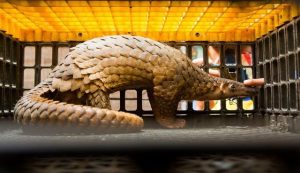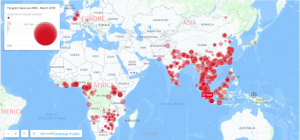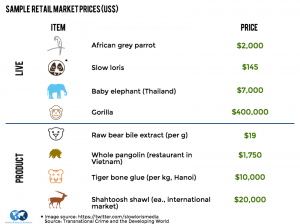12 Illicit market of animals
By Yulia Nefedova
Since ancient times people have liked exotic things like ivory, rhino horns, and tiger skins. People have even kept exotic animals as pets. People have hunted animals for centuries, even driving them to extinction. Today, even though people hunt elephants and rhinos, the most hunted animal is the pangolin (Figure 1) (Todd). People have smuggled more than one million pangolins since 2000, and the number is increasing. The poaching influences the wildlife of the planet, and the government has taken action to prevent illicit animal trade. Though the government passes laws to prevent wild life smuggling, it has not been enough to stop the expansion of the black market trade for animals. The government cannot control the illegal wildlife trade and needs help from wildlife organizations to stop the fast-growing demand on the black market for animals.
 Figure 1. Pangolin in a cage
Figure 1. Pangolin in a cage
Demand for exotic pets emerged in ancient times and has increased with the development of television and the internet. Pharaohs of Egypt were famous for their domestication of exotic animals. For example, Ramses the Second had male lions as pets (TYB). In addition, Pope Leo X had a white elephant. Even one of the most famous musicians in the world, Mozart, had a Starling as a pet. With the development of social media, e-commerce, and TV-programs peoples’ interest in wildlife has increased causing an increased desire for exotic pets. According to Jani Actman, “videos posted to YouTube in 2015 of slow lorises eating rice balls in captivity, became popular and led to poaching of the wide-eyed primates for the pet trade.” After seeing lorises on screens, people wanted to get them as pets without considering that the demand would lead to an animal black market.
People fulfill their demand for exotic pets through social media because it is a powerful resource for communication and participating in illegal wildlife markets. For example, Facebook is a popular network that recently became home to one of the largest black markets for animal parts (Byrne John Aidan). “‘You can go on Facebook today and you’ll see every single endangered species for sale,’ said Stephen Kohn in the ABC News interview” (NWC). With today’s technological advancements, people buy pangolins or other animals online. As John Aidan Byrne wrote: “Welcome to Facebook, home to one of the largest black markets for the illegal buying and selling of the parts of slaughtered endangered animals.” Facebook creates an opportunity for illicit black markets, including for the illicit trade of animals. And Facebook gives this illicit market a global reach for people to get exotic pets or their parts.
Demand for exotic pets on Facebook exists and increases because of people’s desire for a higher status. A 2014 video The Wildlife Warehouse from The Atlantic states that: “Greed really does drive the business. Greed is about having something that is so unique or unusual that your neighbor doesn’t have or very few people have it” (the Atlantic). People create demand for black markets because they want to have something special. They think an exotic animal will give them a specific status in society. In addition, when people buy endangered species, they usually do not know anything about them. “They just think if they keep endangered animals, people will think they are cool” (Gallagher, Sean). Without knowing it, people create a demand for exotic animals because of their greed or demand for higher social status. People believe that getting exotic pets will allow them to become popular and famous, but instead, they encourage criminals to destroy wildlife.
Criminal organizations fulfill the growing demand for exotic pets because it is profitable. Bosses of the mafia, military groups, and other organizations know that the illegal wildlife trade will bring them money: “A congressional report says that wildlife smuggling is sometimes even connected to foreign military groups, insurrectionists and crime syndicates” (Historic Wildlife Bust). The illegal wildlife trade provides not only the finances for black market organizations but also influences criminal activity and other black markets. According to the Government’s Black-Market Animal Warehouse, “U.S. law enforcement agencies have taken down a smuggling network accused of trafficking at least $7 million dollars’ worth of rhino horn and heroin.” The black market of animals is almost impossible to control, and that is why criminal organizations take advantage of it.
Criminal organizations also do not fear being caught because they will not receive a severe punishment for participating in the illicit animal trade. According to the WWF, “Corruption, toothless laws, weak judicial systems and light sentences allow criminal networks to keep plundering wildlife with little regard to consequences” (“Illegal Wildlife Trade.”). People pay fees or receive shortened jail sentences. Only rarely will someone involved in the trade receive a long sentence. For example, Zhifei Li smuggled more than $4.5 million worth wildlife from the US to China and was sentenced to 70 months in prison (“US Imposes One of the Longest Sentences to Wildlife Trader). When people get out of jail, they can continue what they did before – wildlife smuggling or illegal breeding of animals. The low punishment rates and high benefits encourage people to participate in the illegal wildlife trade.
By capturing and killing animals such as pangolins, criminals fulfill the growing demand for exotic animals. Criminal organizations capture a pangolin to sell at an auction or online. In addition, criminal organizations can kill pangolins for their scales that Chinese use in traditional medicine (Todd). In China, a pangolin’s price can be worth $3,000, and 10,000 pangolins are shipped to the country every year. Moreover, “people consider pangolin meat a delicacy, especially in China and Vietnam” (Todd). When people order pangolin in a restaurant, it will often be killed in front of the customers to prove that they are consuming genuine pangolin meat (Todd). Black markets for killing such animals and making them endangered would not exist without a demand for animals.
Breeding operations exist for some exotic animals. However, people cannot breed pangolins in captivity. They have to capture them. In contrast, people do breed tigers in zoos or in wildlife organizations. People can receive specific documentation to sell exotic animals legally. However, do potential buyers know where the sellers obtain tigers before breeding them in captivity? “Countless animals are taken from the wild before they’re sold as pets” (Actman Jany). People obtain animals from the wild illegally and breed them in cages to sell legally and to become rich. For example, “At least 80 percent of the 5,000-plus green pythons annually exported from the country as captive-bred were caught illegally in the wild, according to Biological Conservation” (New York Times). People start “farms” where they treat animals like a resource that they will use in the business.

Figure 2. The Map of illegal trade of pangolin. The map shows the pangolin seizure between 2000 and March 2019 in the world.
After capturing, killing or breeding animals, criminals look for ways to sell animals to a customer on the black market. If criminals want to sell pangolins, they will go to China and Vietnam because they are the main consumers of pangolins. The map in Figure 2 is based on seizures between 2000 and 2018, and the information is from public records. That is why Figure 2 represents only a fraction of the pangolin illegal trade (“Illegal Trade Seizures: Pangolins.”). In addition, China, Vietnam, the Philippines, and Indonesia are the main customers for other wildlife, according to the Environmental Investigation Agency’s maps. Europe and the United States also participate in the illegal wildlife trade, but they are not so involved as South-East Asian countries.

Figure 3. Costs of wildlife on the black market
South-East Asian countries are the main target for illegal wildlife trade because people willingly pay money for animals, making these countries ground zero for the wildlife trade – a place where illegal trade is not under control of the government. The profits are high, as people will pay up to $400,000 for a live gorilla (Figure 3). As a result, so many people are involved in the illegal trade in South-East Asia that it holds a location known as “The Golden Triangle” for the wildlife trade. In the Golden Triangle “where Thailand, Myanmar, Lao PDR, and China meet” (Figure 4), buyers and sellers engage in the illegal trade freely because of the impossibility of police interference. In fact, “casino-resorts, hotels, restaurants, and markets openly sell illegal wildlife products with relative impunity” (“Illegal Wildlife Trade in the Greater Mekong.”). Therefore, South-East Asian countries are a place that willingly buys and sells illegal wildlife.

Figure 4. The Golden Triangle – Ground Zero for a Wildlife trade. This is a place where people can do illicit trade freely without being afraid to get caught by the police or government.
The illegal trade of wildlife has a major impact on flora and fauna of the world. People have already wiped out diverse species from the planet, and they are doing the same with the pangolin. In the past decade, people killed 2.7 million pangolins (NBC Left Field). According to the Environmental Investigation Agency, in ten years the pangolins will disappear. Those involved in the illegal wildlife trade do not care about the animal populations; people kill animals in enormous quantities and do not realize the harm they cause to the environment.
Addressing the market is complex, even when the government wants to protect the environment and discourage poaching. Research conducted at Princeton University assumed that if the sale of some legal ivory was allowed in China and Japan, then fewer people would purchase it illegally (Kelly). However, their assumption was wrong. Partial legalization of ivory “encouraged black-market activity by attracting new customers and by reducing the risk to criminal groups — and thus the expense — of producing, transporting or selling those goods” (Kelly). Legalization of illegal activities can work sometimes with drugs, but it will not work with the illicit trade of animals. Legalization influences three different directions of economics: “some demand satisfied, a potential increase in the consumer base, and reduced cost of smuggling” (Kelly). The illegal wildlife market is more complicated compared to the black market of drugs because the government cannot do enough to combat it.
For example, if the government wants to significantly lessen the illegal wildlife trade, it needs to consider confiscating and destroying the illegal wildlife products. In other words, the government needs to remove a product from the market to demonstrate it is serious about the elimination of the black market of wildlife. According to one of YouTube videos from NBC Left Field, there are 1.5 million items in a warehouse, where the government keeps confiscated illicit wildlife, and every day the number of items increases. Items in the warehouse have been confiscated from smugglers in the United States. But too many products still end up on the black market without notice by the government. To stop it, the government needs to take action to decrease the demand for illicit wildlife products, but it cannot do it by itself.
The high number of products on the market mean governments needs help from wildlife organizations to eliminate the illicit trade of wildlife. Organizations such the WWF or a Worldwide Fund for Nature help to preserve diverse species and spend 84% of resources on worldwide conservation activities. In addition, WWF examines why people become involved in the black market of wildlife, and it tries to eliminate the problem at the beginning. For example, the WWF knows that people go into the illegal wildlife trade because of poverty and lack of alternatives to poaching. To address the lack of knowledge, the organization provides education to poor communities and encourages them to use approved wildlife resources in a sustainable way (WWF). WWF is one of the organizations that helps to prevent wildlife trafficking but there are others. Organizations can decrease the number of trafficked goods, but there will be always a wildlife black market if there is a demand for it.
The illicit market for wildlife is vast and includes many countries. The demand for exotic pets existed for a long time but it increased with the development of social media and the internet. People from all over the world are interested in buying a tiger or bobcat because they think they are cute, or an animal will give an owner status in society. However, they do not consider or care where the animals come from – wild or bred in captivity. People do not even know what they are doing to a the natural habitat of countries by importing a tiger home or its parts. Demand drives business, criminals are looking for a way to satisfy demand, and governments with the help of wildlife organizations are ready to resist this market.
Work Cited.
Actman, Jani. “Exotic pet trade, explained.” Published February 20, 2019. National Geographic. Accessed 10/23/2019. https://www.nationalgeographic.com/animals/reference/exotic-pet-trade/
Byrne, John Aidan. “One of the largest black markets for animal parts is on Facebook.” New York Post. https://nypost.com/2018/05/12/one-of-the-largest-black-markets-for-animal-parts-is-on-facebook/
“Everybody Is Talking About It: Facebook’s Wildlife Black Market.” National Whistleblower Center. https://www.whistleblowersblog.org/2018/05/articles/wildlife-whistleblowers/everybody-is-talking-about-it-facebooks-wildlife-black-market/
“Helping Pangolins.” Environmental Investigation Agency. https://eia-international.org/wildlife/helping-pangolins/
Historic Wildlife Bust Highlights How the Black Market Threatens Ecosystems • Earth.com Zach Fitzner – https://www.earth.com/news/historic-wildlife-bust-black-market/
“Illegal Wildlife Trade.” WWF. Accessed on 10/23/2019. https://www.worldwildlife.org/threats/illegal-wildlife-trade
“Illegal Trade Seizures: Pangolins.” Environmental Investigation Agency. https://eia-international.org/wildlife/wildlife-trade-maps/illegal-trade-seizures-pangolins/
“Illegal Wildlife Trade in The Greater Mekong.” WWF. http://greatermekong.panda.org/challenges_in_the_greater_mekong/illegal_wildlife_trade2/
Reals, Tucker. “How Prince William helped U.S. agents bust major wildlife and drug smuggling network.” CBS News. https://www.cbsnews.com/news/wildlife-heroin-trafficking-ring-africa-bust-southern-district-new-york-fish-and-wildlife/
Kelly, Morgan. “After legal-ivory experiment, black markets thrive from greater demand, less risk.” Princeton University. https://www.princeton.edu/news/2016/06/14/after-legal-ivory-experiment-black-markets-thrive-greater-demand-less-risk
Lehmacher, Wolfgang. “Wildlife crime: a $23 billion trade that’s destroying our planet.” World Economic Forum. https://www.weforum.org/agenda/2016/09/fighting-illegal-wildlife-and-forest-trade/
Mavrellis, Channing. “The Illegal Wildlife Trade: Sample Retail Market Prices.” Global Financial Integrity. https://gfintegrity.org/illegal-wildlife-trade-sample-retail-market-prices/
Nuwer, Rachel. “That Python in the Pet Store? It May Have Been Snatched from the Wild.” The New York Times. https://www.nytimes.com/2018/04/09/science/illegal-wildlife-reptiles-amphibians.html
“The Government’s Black-Market Animal Warehouse: NBC Left Field.” NBC Left Field. Published on Sep. 15, 2017. YouTube https://www.youtube.com/watch?v=AgUmLC_lxA8
“The Wildlife Warehouse: Where the U.S. Government Sends Illegal Animal Goods.” The Atlantic. Published on Jul. 23, 2014. https://www.youtube.com/watch?v=6VraSdp5SWI
Todd, Mark. “Pangolins: One of the world’s least known and most hunted animals.” https://www.fauna-flora.org/news/pangolins-one-of-the-worlds-least-known-and-most-hunted-animals
TYB. “10 Historical Characters and their Unusual Pets.” + LISTVERSE. https://listverse.com/2011/03/18/10-historical-characters-and-their-unusual-pets/
“US Imposes One of the Longest Sentences to Wildlife Trader.” WWF, World Wildlife Fund, 28 May 2014, https://www.worldwildlife.org/stories/us-imposes-one-of-the-longest-sentences-to-wildlife-trader.

